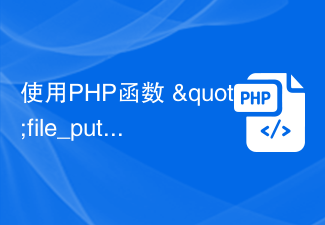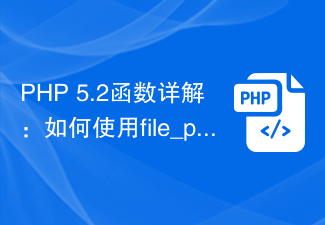 Backend Development
Backend Development PHP Tutorial
PHP Tutorial Detailed explanation of PHP file caching functions: file caching processing methods of file_get_contents, file_put_contents, unlink and other functions
Detailed explanation of PHP file caching functions: file caching processing methods of file_get_contents, file_put_contents, unlink and other functions
Detailed explanation of PHP file caching functions: file caching processing methods of file_get_contents, file_put_contents, unlink and other functions require specific code examples
In web development, we often need to start from Read data from or write data to a file. Moreover, in some cases, we need to cache the contents of a file to avoid frequent file read and write operations, thus improving performance. In PHP, there are several commonly used functions that can help us implement file caching, including file_get_contents, file_put_contents and unlink functions.
- file_get_contents function
The file_get_contents function is used to read the contents of a file into a string. Its basic usage is as follows:
$fileContents = file_get_contents($filename);
where $filename is the name of the file to be read. When using this function, we can change the default behavior of the function by specifying an optional stream context by passing the second parameter. For example, we can set the cache options of the stream context to cache the file content. The following is a specific example:
// 缓存文件的路径和名称
$cacheFile = '/path/to/cache.txt';
// 判断缓存文件是否存在,并且判断缓存是否过期
if (file_exists($cacheFile) && time() - filemtime($cacheFile) < 3600) {
$fileContents = file_get_contents($cacheFile);
} else {
$fileContents = file_get_contents($filename);
file_put_contents($cacheFile, $fileContents);
}In the above example, we first determine whether the cache file exists and determine whether the cache has expired (the judgment here is based on the difference between the modification time of the file and the current time) For this purpose, we set the cache time to 1 hour). If the cache file exists and has not expired, we read the contents of the cache file directly; otherwise, we read the contents from the original file and write the contents to the cache file.
- file_put_contents function
The file_put_contents function is used to write strings into files. Its basic usage is as follows:
file_put_contents($filename, $data);
Among them, $filename is the name of the file to be written, and $data is the data to be written. This function will clear the data in the original file and write the new data to the file.
In the example of caching files, we have used the file_get_contents function when reading the file contents. When writing data to a cache file, we can use the file_put_contents function. The following is a specific example:
// 要写入的缓存文件的路径和名称 $cacheFile = '/path/to/cache.txt'; // 从其他地方获取数据 $data = 'Some data to be cached'; // 将数据写入缓存文件 file_put_contents($cacheFile, $data);
The above example writes $data to the file specified by $cacheFile.
- unlink function
The unlink function is used to delete files. Its basic usage is as follows:
unlink($filename);
Among them, $filename is the name of the file to be deleted. This function deletes the specified file and returns true if the operation is successful; otherwise, returns false.
In some specific cases, we may need to delete cache files. For example, when other data is updated, we may want to delete cache files to keep the data up to date. The following is a specific example:
// 要删除的缓存文件的路径和名称 $cacheFile = '/path/to/cache.txt'; // 删除缓存文件 unlink($cacheFile);
The above example will delete the file specified by $cacheFile.
Summary:
In PHP, we often need to use file operation functions to read and write files. To improve performance, we can use file caching to avoid frequent file read and write operations. The file_get_contents function can read the contents of the file into a string, the file_put_contents function can write the string into the file, and the unlink function can delete the file. By using these functions appropriately, we can achieve effective file caching, thereby improving the performance of web applications.
The above is a detailed introduction to the PHP file caching function and the corresponding code examples. By learning and using these functions, we can better apply file caching to optimize our PHP programs.
The above is the detailed content of Detailed explanation of PHP file caching functions: file caching processing methods of file_get_contents, file_put_contents, unlink and other functions. For more information, please follow other related articles on the PHP Chinese website!
 如何解决PHP Warning: file_get_contents(): Filename cannot be emptyAug 18, 2023 pm 07:30 PM
如何解决PHP Warning: file_get_contents(): Filename cannot be emptyAug 18, 2023 pm 07:30 PM如何解决PHPWarning:file_get_contents():Filenamecannotbeempty在进行PHP开发的过程中,我们经常会遇到这样的错误提示:PHPWarning:file_get_contents():Filenamecannotbeempty。这个错误通常出现在使用file_get_contents函数时
 如何解决PHP Warning: file_get_contents(): failed to open stream: HTTP request failedAug 18, 2023 pm 11:34 PM
如何解决PHP Warning: file_get_contents(): failed to open stream: HTTP request failedAug 18, 2023 pm 11:34 PM如何解决PHPWarning:file_get_contents():failedtoopenstream:HTTPrequestfailed在进行PHP开发过程中,经常会遇到通过file_get_contents函数向远程服务器发起HTTP请求的情况。然而,有时候我们会遇到一个常见的错误提示:PHPWarning:file_get_c
 PHP的file_get_contents()函数:如何从文件中读取内容Nov 04, 2023 pm 01:43 PM
PHP的file_get_contents()函数:如何从文件中读取内容Nov 04, 2023 pm 01:43 PMPHP的file_get_contents()函数:如何从文件中读取内容,具体代码示例在PHP中,file_get_contents()是一个非常有用的函数,它允许我们从文件中读取内容。无论是读取文本文件,还是读取远程URL中的内容,该函数都能够轻松地完成任务。语法该函数的基本语法如下:stringfile_get_contents(string$f
 PHP文件缓存函数详解:file_get_contents、file_put_contents、unlink等函数的文件缓存处理方法Nov 18, 2023 am 09:37 AM
PHP文件缓存函数详解:file_get_contents、file_put_contents、unlink等函数的文件缓存处理方法Nov 18, 2023 am 09:37 AMPHP文件缓存函数详解:file_get_contents、file_put_contents、unlink等函数的文件缓存处理方法,需要具体代码示例在Web开发中,我们经常需要从文件中读取数据或将数据写入到文件中。而且,在某些情况下,我们需要缓存文件的内容以避免频繁的文件读写操作,从而提高性能。在PHP中,有几个常用的函数可以帮助我们实现文件缓存,这其中包
 PHP函数介绍—file_get_contents(): 读取URL的内容到字符串Jul 24, 2023 pm 02:32 PM
PHP函数介绍—file_get_contents(): 读取URL的内容到字符串Jul 24, 2023 pm 02:32 PMPHP函数介绍—file_get_contents():读取URL的内容到字符串在Web开发中,经常需要从远程服务器获取数据或者读取远程文件。PHP提供了一个非常强大的函数file_get_contents(),它可以方便地读取URL的内容并将其保存到一个字符串中。本文将介绍file_get_contents()函数的用法,并给出一些代码示例来帮助读者更好
 使用PHP函数 "file_put_contents" 将字符串写入文件中Jul 24, 2023 am 09:19 AM
使用PHP函数 "file_put_contents" 将字符串写入文件中Jul 24, 2023 am 09:19 AM标题:使用PHP函数"file_put_contents"将字符串写入文件中PHP是一种流行的服务器端脚本语言,它提供了很多方便的函数来处理文件操作。其中一个非常有用的函数是"file_put_contents",它可以将字符串写入文件中。在本文中,我们将探讨如何使用这个函数实现这个功能。首先,我们需要确保PHP的"file_put_contents"函
 PHP 5.2函数详解:如何使用file_put_contents函数写入文件并设置文件锁Jul 30, 2023 pm 04:53 PM
PHP 5.2函数详解:如何使用file_put_contents函数写入文件并设置文件锁Jul 30, 2023 pm 04:53 PMPHP5.2函数详解:如何使用file_put_contents函数写入文件并设置文件锁在PHP5.2及以上的版本中,提供了file_put_contents函数,这个函数可以帮助我们将字符串内容写入文件中。同时,我们还可以通过设置文件锁,确保在写入文件时的数据一致性和并发安全。那么,本文将详细介绍如何使用file_put_contents函数写入文件,
 如何使用PHP中的file_get_contents函数读取文件内容Jun 26, 2023 pm 12:01 PM
如何使用PHP中的file_get_contents函数读取文件内容Jun 26, 2023 pm 12:01 PM在PHP中,我们常常需要从文件中读取数据。在这种情况下,我们可以使用file_get_contents函数。这个函数可以简单地从一个文件中读取所有内容,并将其作为一个字符串返回。这在许多场景下都非常有用,例如读取配置文件、读取日志文件等。在本文中,我们将介绍如何使用PHP中的file_get_contents函数来读取文件内容。步骤1:打开文件在使用file


Hot AI Tools

Undresser.AI Undress
AI-powered app for creating realistic nude photos

AI Clothes Remover
Online AI tool for removing clothes from photos.

Undress AI Tool
Undress images for free

Clothoff.io
AI clothes remover

AI Hentai Generator
Generate AI Hentai for free.

Hot Article

Hot Tools

MantisBT
Mantis is an easy-to-deploy web-based defect tracking tool designed to aid in product defect tracking. It requires PHP, MySQL and a web server. Check out our demo and hosting services.

mPDF
mPDF is a PHP library that can generate PDF files from UTF-8 encoded HTML. The original author, Ian Back, wrote mPDF to output PDF files "on the fly" from his website and handle different languages. It is slower than original scripts like HTML2FPDF and produces larger files when using Unicode fonts, but supports CSS styles etc. and has a lot of enhancements. Supports almost all languages, including RTL (Arabic and Hebrew) and CJK (Chinese, Japanese and Korean). Supports nested block-level elements (such as P, DIV),

Zend Studio 13.0.1
Powerful PHP integrated development environment

Dreamweaver CS6
Visual web development tools

Safe Exam Browser
Safe Exam Browser is a secure browser environment for taking online exams securely. This software turns any computer into a secure workstation. It controls access to any utility and prevents students from using unauthorized resources.





